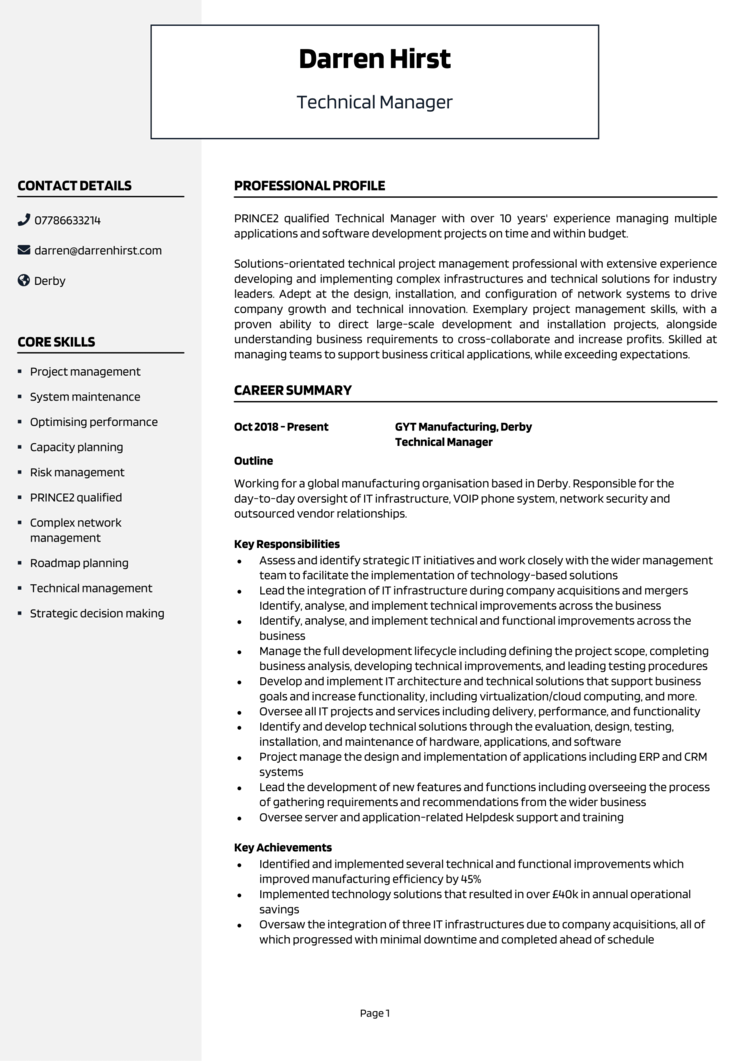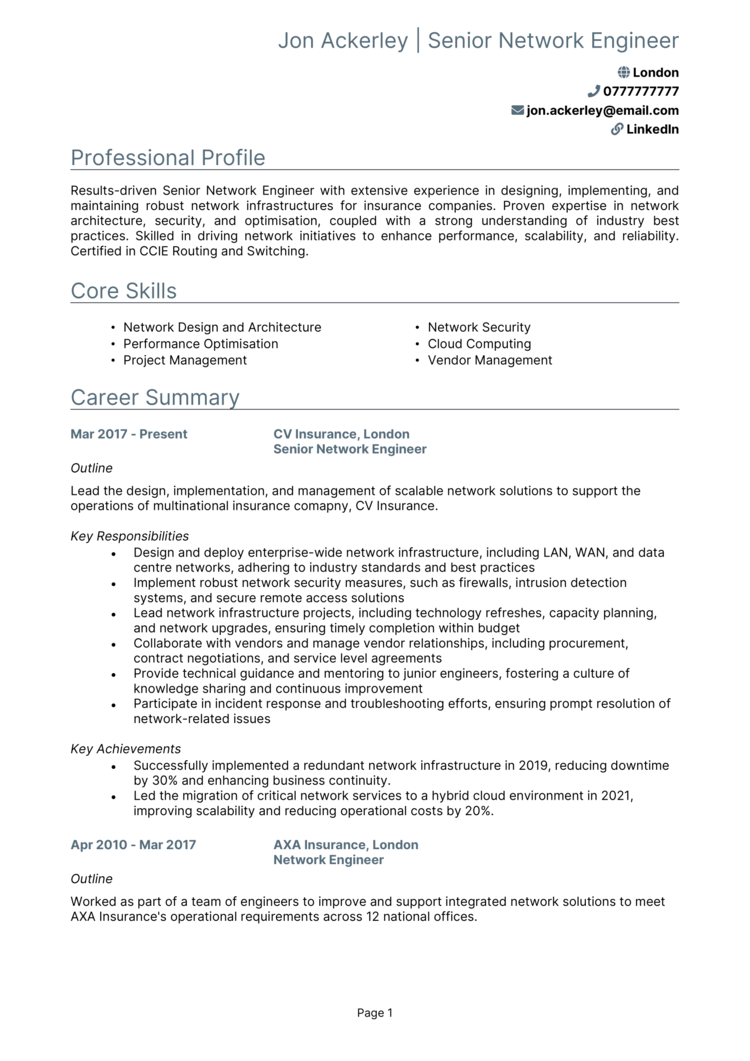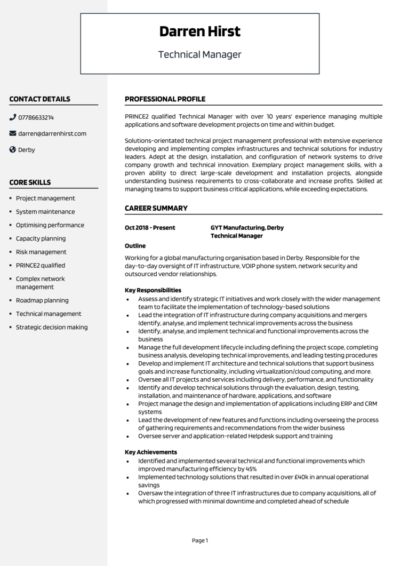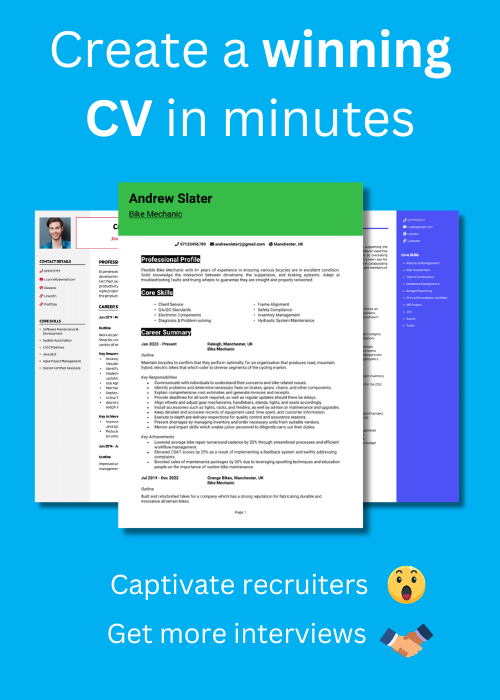A career in technical fields is all about problem-solving, precision, and making things work seamlessly – and your CV should reflect exactly that.
But even the most skilled technical professionals can struggle to put their expertise into words. With technical CV examples and expert tips, this guide will teach you how to build an application that gets interviews and opens doors in any technical field.
Technical Manager CV example

Mechanical Engineer CV example

Network Engineer CV example

How to write your Technical CV
Learn how to create your own interview-winning Technical CV with this simple step-by-step guide.
A technical CV needs to be structured, detailed, and clear – just like the projects you work on. Recruiters and hiring managers are looking for specialised skills, relevant experience, and the ability to apply technical knowledge in real-world scenarios.
This guide will take you through the process of writing a CV, ensuring it highlights your technical expertise, industry experience, and problem-solving abilities while remaining concise and easy to read.
The best way to structure your Technical CV


A well-organised structure is like a well-assembled machine – everything should fit together logically, and nothing should be included if it doesn’t serve a purpose. Keeping your layout structured makes it easier for recruiters to quickly spot the information that matters most.
Here’s how to structure your technical CV:
- Name and contact details – Place contact details, along with an optional photo of yourself, at the top so employers can easily reach you. .
- Profile – A concise overview of your technical expertise and career highlights.
- Core skills – Focus on key competencies like software proficiency, mechanical design, or project management.
- Work experience – Detail your roles in reverse chronological order, prioritising technical contributions and achievements.
- Education – List degrees, certifications, and relevant training.
- Additional info – Optionally, include hobbies and interests and awards that demonstrate problem-solving or technical curiosity.
Technical CV format


Your format needs to be as precise as your technical work. Poor formatting can make even the most experienced candidate look unorganised, so ensure your layout is clean and free from mistakes.
Follow these formatting tips:
- Bullet points – Break down key details to improve readability.
- Divide sections – Use clear headings so recruiters can easily find what they need.
- Use a clean font – Prioritise readability with a professional font that makes scanning easy.
- Keep it the right length – No more than two pages – enough length to cover your expertise in your CV without overloading the reader.
Writing a Technical CV profile


Your profile is the first thing a recruiter will read, so it should quickly summarise your technical abilities, industry experience, and career highlights. A couple of sentences should be enough to make an impact.
Junior candidates should consider a personal statement, along with an extended cover letter, if a profile doesn’t provide enough space.
Technical CV profile examples
Profile 1
Detail-oriented Technical Specialist with four years of experience in IT support and system administration. Skilled in troubleshooting hardware and software issues, configuring networks, and maintaining security protocols. Proficient in Windows, Linux, and cloud platforms such as AWS and Microsoft Azure. Passionate about optimising IT operations and providing efficient technical solutions to business challenges.
Profile 2
Analytical Technical Engineer with three years of experience in product development and system integration. Specialises in troubleshooting, performance optimisation, and working with cross-functional teams to implement innovative solutions. Proficient in Python, SQL, and embedded systems, with hands-on experience in IoT and automation technologies.
Profile 3
Experienced Technical Consultant with over six years of expertise in software implementation, system architecture, and business process optimisation. Adept at liaising with clients to understand technical requirements and deliver tailored solutions. Proficient in Agile methodologies, cloud computing, and API integrations. Passionate about streamlining workflows through automation and scalable technology.
What to include in your Technical CV profile
Here are some key points to include in your technical CV profile:
- Where you’ve worked – Mention industries or companies relevant to the role you’re applying for.
- Your top qualifications – Include degrees, certifications, or industry-recognised training.
- Essential skills – Highlight your most relevant technical competencies.
- Technical projects you’ve worked on – Briefly mention major projects or innovations.
- Tools and technologies – List software, equipment, or methodologies you are proficient in.
Core skills section


A strong technical CV showcases the tools and methods you use to get results. The CV skills section should be a quick, at-a-glance reference for your expertise.
Rather than listing soft skills, focus on the most important technical abilities that align with the job description. Whether it’s programming languages, CAD software, or engineering principles, this section should reflect what makes you a strong candidate.
What are the most important skills for a Technical CV
- System Analysis – Evaluating technical systems to identify inefficiencies, optimise performance, and recommend improvements.
- Programming and Scripting – Writing and debugging code in languages like Python, Java, C++, or JavaScript for software development and automation.
- Database Management – Designing, maintaining, and querying relational and NoSQL databases for efficient data storage and retrieval.
- Cloud Computing – Implementing and managing cloud-based solutions using platforms like AWS, Azure, or Google Cloud.
- Cybersecurity Protocols – Applying encryption, access controls, and threat mitigation strategies to secure systems and data.
- Networking and Infrastructure – Configuring and managing network systems, firewalls, and VPNs for optimal connectivity and security.
- Data Analytics and Visualisation – Using tools like SQL, Power BI, or Tableau to analyse and present complex datasets effectively.
- Software Development Life Cycle (SDLC) – Managing the end-to-end process of software development from planning to deployment.
- Technical Troubleshooting – Diagnosing and resolving hardware, software, and network issues to maintain operational efficiency.
- Automation and Scripting – Implementing automated workflows and scripts to streamline repetitive technical tasks.
Work experience


Your work experience section should focus on the real-world impact of your technical expertise. Employers want to see how you’ve applied your skills to solve problems, improve processes, and contribute to project success.
List your roles in reverse chronological order, beginning with your most recent experience. Use bullet points to highlight your key responsibilities and accomplishments while keeping descriptions concise.
Writing job descriptions for past roles

- Outline – Describe the company, your role, and the type of projects you worked on.
- Responsibilities – Detail core duties such as designing solutions, troubleshooting technical issues, or leading engineering teams.
- Achievements – Highlight measurable results, like improving system efficiency, reducing downtime, or increasing productivity. Use numbers where possible to quantify your contributions.
Example jobs for Technical
Technical Support Engineer | Innovate IT
Outline
Provided first-line technical support for enterprise clients, troubleshooting software and hardware issues to ensure minimal downtime and optimal system performance.
Responsibilities
- Diagnosed and resolved IT issues across Windows, macOS, and Linux operating systems.
- Configured and maintained network infrastructure, ensuring seamless connectivity.
- Managed user accounts and permissions in Active Directory and Office 365.
- Provided remote support using ticketing systems such as ServiceNow and Zendesk.
- Documented troubleshooting processes to improve internal knowledge sharing.
Achievements
- Resolved 90 percent of IT tickets within SLA targets, reducing system downtime.
- Implemented a new helpdesk workflow, improving ticket resolution efficiency by 25 percent.
- Recognised for delivering excellent customer support and maintaining high satisfaction scores.
Technical Consultant | CloudTech
Outline
Advised clients on cloud migration strategies and system integration, ensuring smooth implementation of scalable IT solutions.
Responsibilities
- Assessed business requirements to recommend cloud-based solutions using AWS and Microsoft Azure.
- Designed and implemented API integrations to streamline data flows between enterprise systems.
- Conducted training sessions for clients on new software tools and best practices.
- Collaborated with development teams to customise software solutions based on client feedback.
- Prepared technical documentation and reports outlining project progress and challenges.
Achievements
- Successfully migrated a client’s legacy infrastructure to the cloud, reducing costs by 30 percent.
- Developed an automation script that reduced manual data processing time by 40 percent.
- Achieved a 95 percent client satisfaction rate by delivering tailored, high-quality solutions.
Technical Engineer | NextGen Robotics
Outline
Supported the development and testing of automation systems for industrial applications, ensuring reliability and efficiency in robotic workflows.
Responsibilities
- Designed and tested embedded systems for automation and IoT applications.
- Troubleshot and optimised robotic hardware and firmware for improved efficiency.
- Developed scripts in Python and C++ to automate repetitive system tasks.
- Worked closely with manufacturing teams to ensure seamless integration of robotics into production lines.
- Conducted performance analysis and provided recommendations for system improvements.
Achievements
- Optimised robotic algorithms, increasing production efficiency by 20 percent.
- Reduced system errors by 15 percent through rigorous testing and debugging processes.
- Received recognition from senior engineers for innovative problem-solving and technical expertise.
Education section


The education section is essential in technical roles, as it demonstrates your knowledge and qualifications.
Include relevant degrees, certifications, and specialised training. If you have extensive experience, keep this section concise. However, if you’re early in your career, highlight coursework, research projects, or technical training that showcase your capabilities.
Always list qualifications in reverse chronological order, starting with the most recent.
Qualifications recruiters look for in a Technical CV
- Bachelor’s or Master’s Degree in Engineering, IT, or a Technical Field – Demonstrates industry-specific knowledge and expertise.
- Chartered Engineer (CEng) Certification – Recognised accreditation for engineers in the UK.
- Certified Information Systems Security Professional (CISSP) – Highly regarded for IT security professionals.
- Lean Six Sigma Certification – Useful for professionals in manufacturing, process improvement, and project management.
- AutoCAD or SolidWorks Certification – Important for those in mechanical or civil engineering roles.





